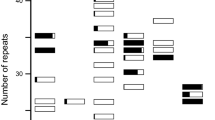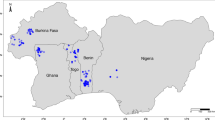Abstract
Risk-prone agriculture by resource-poor tribal farmers in Kolli hills, south India is slowly giving way to commercial exploitation for paltry compensation thus eroding genetic diversity of millets. Cultivation and conservation of millets, particularly, little millet (Panicum sumatrense Roth ex Roem. et Schult.), called samai in the local language, Tamil are on the wane. Whether irregular and sparse cultivation of little millet by tribals has an impact on the current level of genetic divergence is also not clear. Therefore genetic divergence among 7 landraces and 1 check variety was evaluated based on morphometric traits at two sites over two seasons. The seven landraces formed six distinct groups with high inter-group distances. Days to maturity and flowering time contributed the most to genetic differentiation. Principal component analysis confirmed the results of divergence analysis. But a recent molecular analysis of diversity reported that the landraces were all genetically uniform and any observed diversity could be due environmental variation. An analysis of the contradictory results only emphasized the fact that lack of polymorphism need not imply lack of genetic divergence. The findings co evaluated with relevant published work highlight the value of morphometric analysis and reveal sustained genetic divergence in little millet.
Similar content being viewed by others
References
Arunachalam V. Bandyopadhyay A. 1989. On the method of classification using D2 statistic and the importance of characters contributing to genetic divergence. Indian J. Genet. 49: 227–230.
Doebley J. Stec A. Gustus C. 1995. Teosinte branched 1 and the origin of maize: Evidence for epistasis and the evolution of dominance Genetics 141: 333–346.
Gupta P.K. Varshney R.K. 1999. Molecular markers for genetic fidelity during micropropagation and germplasm conservation Current Science 76: 1308–1310.
MSSRF2000. Annual Report, 1998–99 M.S. Swaminathan Research Foundation Chennai
Pardue M.L. 1991. Dynamic instability of chromosomes and genomes Cell 66: 427–431.
Rao C.R. 1952. Advanced Statistical Methods in Biometrical Research. John Wiley and Sons New York
Singh D. 1981. The relative importance of characters affecting divergence Indian J. Genet. 41: 237–245.
Teshome A. Baum B.R. Fahrib L. Torrance J.K. Arnason T.J. Lambert J.D. 1997. Sorghum [Sorghum bicolor (L.) Moench] landrace variation and classification in North Shewa and South Welo, Ethiopia. Euphytica 97: 255–263.
Worede M. Mekbib H. 1993. Linking genetic resource conservation to farmers in Ethiopia. In: de Boef W. Amanor K. Wellard K. Bebbington A. (eds), Cultivating knowledge Intermediate Technology Publications London, pp. 78–84.
Author information
Authors and Affiliations
Rights and permissions
About this article
Cite this article
Arunachalam, V., Rengalakshmi, R. & Kubera Raj, M.S. Ecological stability of genetic diversity among landraces of little millet (Panicum sumatrense) in south India. Genet Resour Crop Evol 52, 15–19 (2005). https://doi.org/10.1007/s10722-005-6693-4
Received:
Accepted:
Issue Date:
DOI: https://doi.org/10.1007/s10722-005-6693-4




